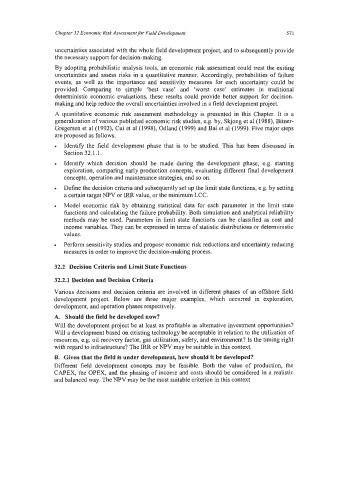Page 595 - Marine Structural Design
P. 595
Chapter 32 Economic Risk Assessment for Field Development 57 1
uncertainties associated with the whole field development project, and to subsequently provide
the necessary support for decision-making.
By adopting probabilistic analysis tools, an economic risk assessment could treat the exiting
uncertainties and assess risks in a quantitative manner. Accordingly, probabilities of failure
events, as well as the importance and sensitivity measures for each uncertainty could be
provided. Comparing to simple ‘best case’ and ‘worst case’ estimates in traditional
deterministic economic evaluations, these results could provide better support for decision-
making and help reduce the overall uncertainties involved in a field development project.
A quantitative economic risk assessment methodology is presented in this Chapter. It is a
generalization of various published economic risk studies, e.g. by, Skjong et a1 (1988), Bitner-
Gregersen et a1 (1992), Cui et a1 (1998), Odland (1999) and Bai et a1 (1999). Five major steps
are proposed as follows.
Identify the field development phase that is to be studied. This has been discussed in
Section 32.1.1.
Identify which decision should be made during the development phase, e.g. starting
exploration, comparing early production concepts, evaluating different final development
concepts, operation and maintenance strategies, and so on.
Define the decision criteria and subsequently set up the limit state functions, e.g. by setting
a certain target NPV or IRR value, or the minimum LCC.
Model economic risk by obtaining statistical data for each parameter in the limit state
functions and calculating the failure probability. Both simulation and analytical reliability
methods may be used. Parameters in limit state functions can be classified as cost and
income variables. They can be expressed in terms of statistic distributions or deterministic
values.
Perform sensitivity studies and propose economic risk reductions and uncertainty reducing
measures in order to improve the decision-making process.
32.2 Decision Criteria and Limit State Functions
32.2.1 Decision and Decision Criteria
Various decisions and decision criteria are involved in different phases of an offshore field
development project. Below are three major examples, which occurred in exploration,
development, and operation phases respectively.
A. Should the field be developed now?
Will the development project be at least as profitable as alternative investment opportunities?
Will a development based on existing technology be acceptable in relation to the utilization of
resources, e.g. oil recovery factor, gas utilization, safety, and environment? Is the timing right
with regard to infrastructure? The IRR or NPV may be suitable in this context.
B. Given that the field is under development, how should it be developed?
Different field development concepts may be feasible. Both the value of production, the
CAPEX, the OPEX, and the phasing of income and costs should be considered in a realistic
and balanced way. The NPV may be the most suitable criterion in this context

